Fueled by the popularity of Nest, thermostats remain one of the more popular categories of smart home devices. I recently took at look at Honeywell's Lyric Round thermostat with HomeKit support, and today I'm following up with Emerson's latest HomeKit model, the Sensi Touch.

Announced back in May and launched in June, the Sensi Touch offers a horizontal design with a color touchscreen taking up much of the front of the device. Aside from onscreen controls, the Sensi Touch can also be managed via app or through HomeKit, offering a number of options for controls.
Installation
I've had a bit of previous experience swapping out thermostats, so I was already familiar with what needed to be done, and all told it took me less than 30 minutes to remove my old thermostat and get the Sensi Touch installed. After making sure the circuit breakers for my heating and air conditioning system were turned off, I launched the Sensi app on my iPhone and it walked me through all of the steps to get up and running.

It's a great setup process, with easy to follow instructions that integrate with the iPhone's Camera app to take a photo of your existing thermostat wiring for reference, as well as a terminal picker that lets you tell the app exactly which wires your current system uses so that it can guide you in connecting the Sensi Touch.

As with most other thermostats, the Sensi Touch comes in two pieces, a rear plate that is screwed to the wall and contains the terminals for the wiring coming out of the wall, paired with a main body that snaps onto the rear plate for a clean look.
The Sensi Touch's rear plate is well designed, using small paddles under each terminal to secure the wires in their terminals. The paddles are big enough to press with your finger, yet the terminal array remains compact on the rear plate.
The rear plate also includes a handy light that can be operated by switch to help you see what you're doing while connecting the wires. Once the thermostat is fully operational, this light can also be used as a night light to backlight the entire thermostat, but allowing it to be used during setup even without the main body of the thermostat installed is a really nice touch.

The Sensi Touch rear plate includes a pair of screw holes for mounting, one each with play in the horizontal and vertical directions to allow some flexibility. A built-in bubble level makes it easy to ensure everything is lined up properly. Unfortunately, my troublesome thermostat wiring setup with a full junction box located in the wall caused a few problems for me, albeit in a slightly different way than with the Honeywell Lyric Round.
On the positive side, the holes in the Sensi Touch rear plate line up perfectly with the junction box holes, making it simple to mount the thermostat. But its slim profile means the entire thermostat isn't much larger than the junction box itself, and so a bit of rough drywall cutout around the box as well as a screw hole from my Lyric Round installation are visible even with the Sensi Touch fully installed. The screw hole is easy enough to patch, but cleaning up the ragged drywall along the top will be a bit more work.
Setup and App Controls
After the Sensi Touch is mounted to the wall and the circuit breakers are turned back on, the Sensi app continues to walk you through the setup process, allowing you to configure Wi-Fi and connect to HomeKit.

Once it's connected, you can use either the thermostat interface itself or the Sensi app to set up schedules based on time and day of the week, automatically changing temperature set points throughout the day to account for comfortable sleeping conditions, times when you're up and about, and times when you're away.

Oddly, schedules can only be set directly on the Sensi Touch if you turn off Wi-Fi on the thermostat, and as I unfortunately discovered, once you turn off Wi-Fi there's apparently no way to turn it back on and reconnect to the app without completely resetting the thermostat.
Display
While the Sensi Touch includes a color display, it retains a relatively monochromatic appearance to keep the look simple, opting for white text on various shades of either blue when in cooling mode or orange when in heating mode.

If you choose to manage schedules through the app, the functionality available through the thermostat is rather basic, primarily consisting of adjustments to the temperature setting and changing the fan and heating/cooling modes. Manually adjusting the temperature when a schedule is in effect will temporarily hold the new temperature until the next schedule change or for at least two hours.

Other options include preferences for the home screen such as whether to show indoor humidity and the time of day, as well as whether to use Fahrenheit or Celsius units. A separate page in the settings lets you turn on the backlight for use as a night light.

When you're not interacting with the thermostat, you have the option of showing a blank screen or a dimmed screen that shows only the current inside temperature, again on a blue background for cooling or an orange background for heating. It's a very bland look considering the large, color display, and I'd definitely prefer something a bit more interesting.
Sensi App
The app is pretty straightforward, offering a main screen that lets you manage multiple thermostats and then a summary screen for each thermostat that prominently displays the current temperature and humidity, as well as the weather for your location and the set point of the thermostat. Adjusting the set point is simple, requiring just a tap on arrows along the right side of the screen to raise or lower the temperature.
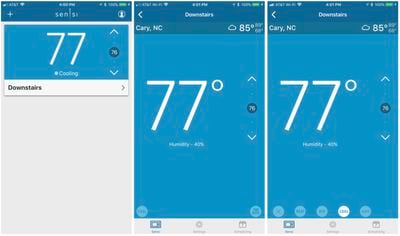
At the bottom of the main display are a pair of buttons, one that lets you change the mode among heating, cooling, automatic, or off, and the other that sets the fan to automatic or always-on. I wish those buttons were a little bigger as hit targets, but you're not going to need to use them very often, so it's not a big deal.

Additional tabs for each thermostat are accessible along the bottom of the screen. One is a Settings tab that primarily displays your setup information but also lets you adjust a few options such as whether temperatures are displayed in Fahrenheit or Celsius and whether the humidity and current time are displayed. More advanced settings include the ability to delay cooling on rapid cycles to prevent system damage, lock out control for the thermostat itself, customize an offset if the thermostat reads a different temperature than you expect, and change heating and cooling cycle rates.
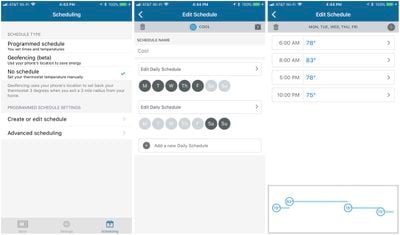
The final tab is for Scheduling, which allows you to create or edit schedules based on time and day of the week and adjust temperatures based on activity in the home. A couple of advanced options let you create multiple schedules in case your needs vary from week to week and turn on an "Early Start" toggle that intelligently starts your heating or cooling early so that your home reaches your desired temperature right at the scheduled time.
The Sensi Touch also includes a beta geofencing feature, which will automatically set back the thermostat by three degrees once you're more than three miles from home in order to save energy. It's not as advanced as Honeywell's geofencing which lets you define a custom radius and customize the set point for when you're away, but at least it's something.
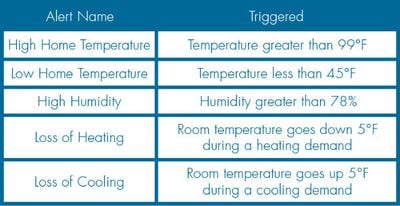
The Sensi Touch will send alerts in a variety of situations to let you know of problems with your heating and air conditioning system, such as if inside temperature reaches 99ºF or 45ºF, humidity exceeds 78 percent, or inside temperature goes up or down by 5ºF even though the system is trying to cool or heat. It would be nice if these thresholds were customizable, but at a minimum the 5º alert should cover most circumstances where your system has failed. It would also be nice if the app could send reminders to change your air filters.
HomeKit
As a HomeKit thermostat, the Sensi Touch works with the Home app on iOS to help you see all of your HomeKit-compatible smart home devices in one app. You can easily adjust the thermostat's temperature setting via the Home app or Siri, and you can incorporate it into scenes and triggers to integrate with other HomeKit accessories. For example, you can include the thermostat in a "Good night" scene that locks your front door, turns off lights, and adjusts the thermostat when you're heading for bed.

Beyond simple temperature and mode settings and automation through HomeKit, other settings must be adjusted either on the thermostat itself or through the Sensi app.
Wrap-up
Emerson's Sensi Touch is a nice addition to the HomeKit thermostat market. Its large color display is visually engaging when you're interacting with it, although I wish it took better advantage of the display even when you're simply glancing at it. The Sensi Touch's touchscreen controls are responsive and setup is extremely easy, with a great app that walks you through everything you need to do.
On the downside, I wish the geofencing features were a little more robust, as I appreciated the customizability offered by Honeywell. The Sensi Touch also lacks many of the learning features that are the hallmark of Nest's thermostats and which contribute significantly to energy savings. Finally, the inability to easily adjust schedules directly from the thermostat can be inconvenient.
At a list price of $200, the Sensi Touch is obviously much more expensive than a traditional thermostat, even digital ones that offer scheduling features, but it's competitive with other smart thermostats, particularly if you can find it cheaper such as through Amazon where we've occasionally seen it for as low as $159 through third-party sellers, but availability varies significantly and pricing is more typically in the $180–$200 range.
Note: Emerson provided the Sensi Touch to MacRumors free of charge for the purposes of this review. No other compensation was received. MacRumors is an affiliate partner with Amazon and may earn commissions on purchases made through links in this article.


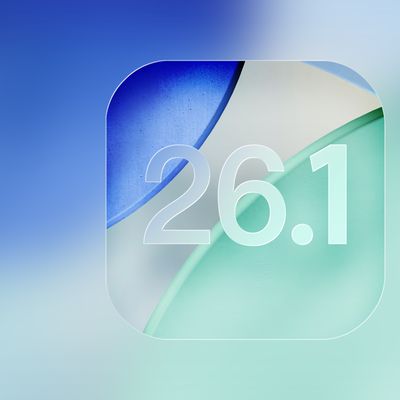
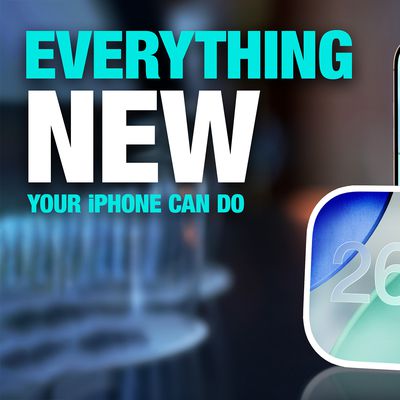



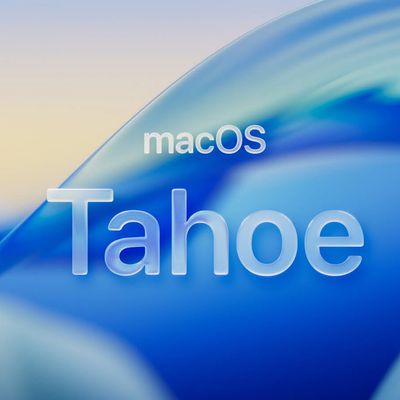
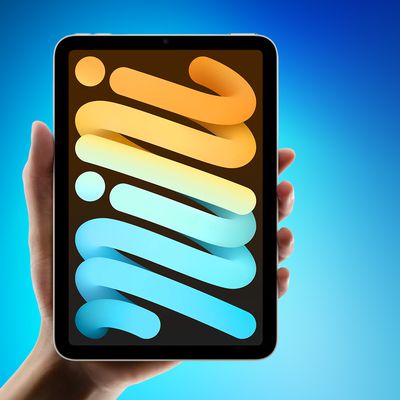












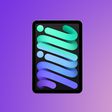

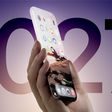
Top Rated Comments
The Nest definitely will not save on cooling bills. The "away" temperature cannot be set any lower than 76 degrees for cooling. There is no way I would let my house get that hot. That is a sauna. It would take hours and hours to cool down to a comfortable temperature on a hot day after arriving home. No savings. It can, however, save some money on heating, since a house with forced air heating can heat up in a few minutes.
I also run homebridge on my iMac, which is a hack to make the Nest work with homekit. When I wake up hot in the middle of the night, I can just say, "Hey Siri, set the temperature at X degrees", and the A/C kicks on. That's livin' in the year 2017! And, I love it.
I know this was a bit of a rant, but, hopefully it gives you some useful info. Also, don't get a Nest.
Projected Savings
$2 per weekday per summer month date
* 10 weeks of peak "summer months" heat where we live, 5 weekdays per week
= $100/year projected savings in Summer AC alone (haven't factored in "smarter" heating savings yet)
Actual Costs
$169 for an ecobee3 lite unit replacing upstairs Honeywell programmable thermostat
- $50 PG&E rebate for purchasing a "smart" thermostat to replace a standard programmable or manual thermostat
= $119 initial costs
Projected ROI Break-Even Interval
$119/$100 = 1.19 years
Actual Savings
$8.50 per weekday per summer month date
* 10 weeks of peak "summer months" heat where we live, 5 weekdays per week
= $425/year projected savings (which is $35/month, about 10%, off our "budget plan" PG&E bill)
Actual ROI Break-Even Interval
$119/($8.50*5) = 2.8 weeks
The upgrade paid for itself with lots of room to spare within the first billing cycle. Even comparing this years much-harsher mid-July-to-mid-August period versus last year's unseasonably mild summer, we spent $150 less in the month (comparing to 2015, we spent over $300 less in the month). July had been $100 more in electricity than the previous year, and July was closer to "normal" than August was.
Yes, that is fueled by exorbitant PG&E electricity costs, but even if your electricity is half national average (a quarter of PG&E's) but you have a similar time-of-day "peak" period surcharge, you'd see a return on that investment in just over a year.
Are there other cheaper thermostats which can do 6+ temperature changes over the course of a scheduled day? Probably. In our minds, though, every day spent researching that instead of going with a solution we strongly suspected would work was costing us money (actually ended up being more of a delay cost than we'd expected). How many "periods" per day a thermostat supports is, oddly, not at all a highly-publicized number, so we contacted multiple manufacturers of cheaper devices which would have had initial costs more in the $90 range but they all seemed content with the Honeywell model of four periods per day, two on weekends. In the end, we spent over a week comparing, which ended up eating through all potential savings and then some, while we had expected that time period to eat through no more than half the potential savings if it panned out.
Our next investment is doing the same for the downstairs thermostat, with much larger effect over the winter months. For that, we are looking into occupancy sensors and so the investment will be a little more, but we figure the "bonus" savings we have achieved over the summer will be put towards the risk of that larger investment not paying off as quickly. And, the occupancy sensors would be saving us AC costs over the summer as well, allowing us to better control what the AC does when no one is home given that no one ever has been able to be trained to turn down the thermostat when they leave the house (although Homekit integration and "Hey Siri, set upstairs thermostat to Away" makes that happen much more often than it ever did with 100-button-presses needed to do the same on the old Honeywell wall units).
And, as a bonus for all that, we have a really nice integration of the thermostats with our house, able to see what the temp is at home while we are away, or upstairs without leaving the couch downstairs. Even discounting all the "nice to have" "techno-lust" features, the device has paid for itself twice over already.
[doublepost=1504803272][/doublepost]When HVAC is more of an "afterthought" the most likely issues are:
1. Heating/cooling losses due to insufficient insulation
2. Inadequately balanced ducting leading some rooms to get more conditioning than others
The net effect is "hot" and "cold" spots in the house.
Any programmable thermostat which relies on only the thermometer behind the unit housing is going to fare very poorly in such situations: when someone is sitting in the office and the temp in there is too hot, they will go turn up the AC at the thermostat, even though that is making the living room too cold.
The 'ecobee' system (which I'm hoping gets reviewed next) accounts for this by allowing you to place relatively cheap per-room occupancy+temperature sensors in each room of the house, then tell the thermostat which rooms should always be kept in the comfort range and which should be kept in that comfort range only when people are in it. You can also use the data from those sensors to better balance out your register openings to keep the whole house evenly heated/cooled (and to know when some dip in the office decided to open the register all the way up leaving the rest of the house less conditioned and now the office is ten degrees cooler than the living room even though no one is in it).
Ideally, we'd see "register controls" which open those individual registers when occupancy is detected, so not only does the office temp not figure in to the "should the AC be running?" calculation if no one is in there, it will get less cooled air being sent into it when there is no one there as well. But, I haven't been able to find such controllable air vent registers yet.
[doublepost=1504803635][/doublepost]Yes, modern thermostats will control both of those systems. Most will have four general modes: "Off" where no matter what the temp nothing happens, "Cool" where only the cooling apparatus will be used if the temperature rises too high, "Heat" where the heating apparatus will be used if the temperature gets too cool, and "Auto" where the heating or cooling apparatus will be used to keep the temperature within a defined range. In the wiring, in a completely separated system like this I'd expect you to have an "Rc" (cooling) and an "Rh" wire, in addition to the cooling/heating/fan control wires. Most thermostats (perhaps with the exception of the new cheaper Nest) should be able to cover this. You will want to check compatibility with your evaporative cooler (we call those "swamp coolers" around here) though, as I think the control for that might be different, as is the case with heat pumps.